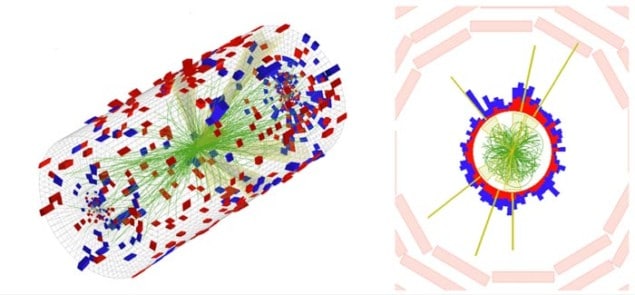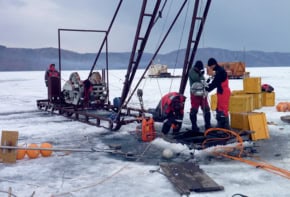
The first data from proton–lead collisions at the Compact Muon Solenoid (CMS) experiment at the Large Hadron Collider (LHC) at CERN include a “ridge” structure in correlations between newly generated particles. According to theorists in the US, the ridge may represent a new form of matter known as a “colour glass condensate”.
This is not the first time such correlations have been seen in collision remnants – in 2005, physicists working on the Relativistic Heavy-Ion Collider (RHIC) at Brookhaven National Laboratory in New York found that the particles generated in collisions of gold nuclei had a tendency to spread transversely from the beam at very small relative angles, close to zero. A similar correlation was seen in 2010 at CMS in proton–proton collisions and then later that year in lead–lead collisions. (See image below, parts a and b.)
Observing ridges
When a graph is plotted of the fraction of particles versus the relative transverse emission angle and the relative angle to the beam axis, the correlation appears as a distinct ridge. Now, this ridge has been seen in proton–lead collisions for the first time – within a week of data collection at CMS (see image below, part c) (arXiv:1210.5482).
Although observations of ridges in different experiments would suggest a single cause, theorists believe there may be more than one explanation. When pairs of nuclei (such as gold or lead) collide, they can produce a hot, dense medium similar to quark–gluon plasma, a type of matter thought to have existed very soon after the Big Bang. The motion of this plasma probably correlates the underlying particles into the ridge structure.
Proton–proton collisions, on the other hand, are not expected to form a quark–gluon plasma, so theorists have come up with other explanations. One idea, presented by Raju Venugopalan at Brookhaven National Laboratory in the US and Kevin Dusling at North Carolina State University in Raleigh, US, is that the ridge correlation is an unusual type of quantum entanglement in which generated particles carry information about the state of protons before those protons collided.
Particle swarms
At very high energies, protons can fluctuate into quantum states that incorporate not just three quarks – their normal constituents – but a swarm of accompanying gluons, the carriers of the strong force. Venugopalan and Dusling think this swarm could have been so dense in proton–proton collisions at CMS that it reached “maximum occupancy” – saturation, in other words – and thereby turned into a colour glass condensate – a hypothetical and controversial form of matter that could explain certain problems in high-energy physics, such as how particles are generated in collisions.
The colour-glass-condensate interpretation of CMS’s 2010 proton–proton ridge was not widely accepted. However, shortly before the latest CMS results were published, Venugopalan and Dusling predicted that, if it existed in the proton–proton collisions, the condensate should also exist in proton–lead collisions. In other words, the theorists predicted that the ridge in proton–lead collisions should bear a greater resemblance to that in proton–proton collisions than that in lead–lead collisions, which are a consequence of a quark–gluon plasma (arXiv:1210.3890).
As predicted
Venugopalan and Dusling say that the new CMS data match their prediction, and that they are preparing a follow-up paper to describe their conclusions. “A more detailed analysis will cast more light on our theories, and hence [on] the fascinating collective behaviour of gluon states that make up the structure of matter at high energies,” says Venugopalan.
Still, other theorists are likely to have their own interpretations of the data. Writing for the collaboration’s public website, CMS experimentalists Wei Li and Gunther Roland refer to the ridge structure as an unexplained phenomenon, and look forward to a longer proton–lead run at the LHC next year that will increase the data sample a thousand fold. “Combined with the surprisingly large magnitude of the ridge seen by CMS, this will enable detailed correlation studies and open a new testing ground for basic questions in the physics of strongly interacting systems and the nature of the initial state of nuclear collisions,” they write.
The work has been submitted to Physics Letters B. A preprint is available on arXiv.




